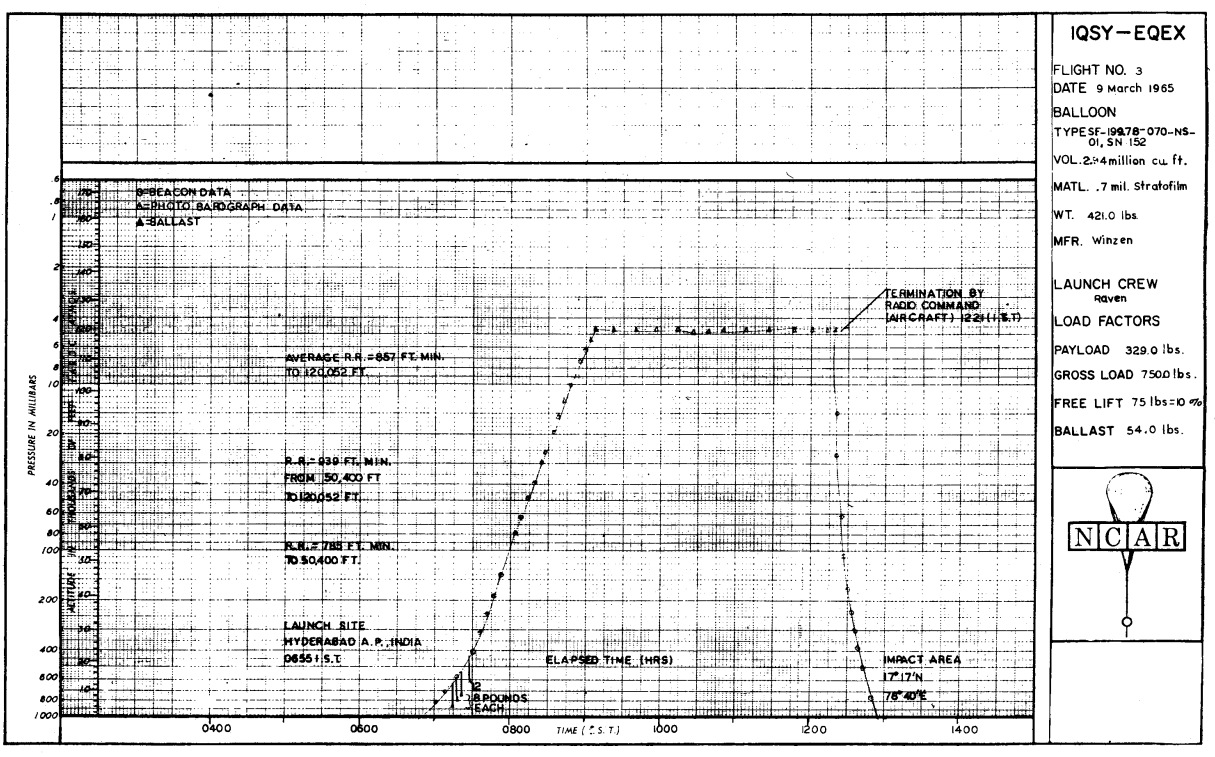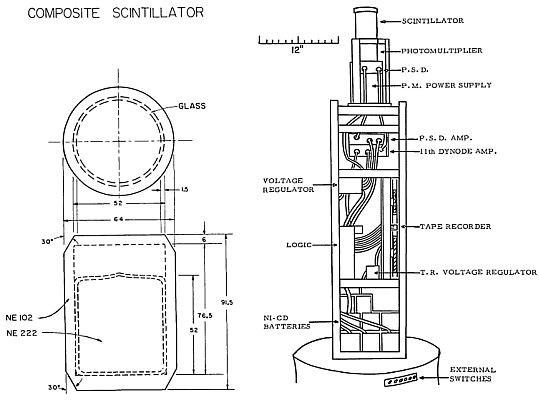Purpose of the flight and payload description
This flight was part of a balloon expedition to study cosmic rays in the vicinity of the equator during the International Quiet Sun Year (IQSY) organized and managed by the National Center for Atmospheric Research as a joint United States - India activity. The program was conducted in Hyderabad, India during the late winter and early spring of 1965.
The main instrument on this flight was a fast neutron detector aimed to measure 1-10 Mev recoil-proton and heavily ionizing events produced by neutrons in an organic scintillator. The detector itself is a 5 cm x 5 cm cylindrical volume of organic liquid phosphor, which is surrounded by a 6 mm minimum thickness of plastic scintillator which acts as an anticoincidence shield for charged particles. The composite detector is viewed by a single 5 cm photomultiplier. The set is shown in the far left scheme.
Events produced in the composite scintilator by radiation other than neutrons (like protons and electrons produced by background radiation and gamma rays) are rejected by the detector electronics on the basis of pulse shape. The pulses produced by scintillations of recoil-protons between 1 and 10 MeV are amplified, gated as neutron events and sorted in a seven-channel pulse height analyzer. The seven channels of pulse height information are binary coded and recorded on three tracks of a four track magnetic tape recorder. The fourth track contains a time signal as well as a record of all events produced in the scintillator with a light output greater than that of 1 MeV proton. Ambient pressure, the temperature of the gondola, and time are registered by a photobarograph which also acts as a backup system for the tape recorder, registering the counts in neutron channels 1-5 and 4-7 and in total events.
The instrumented rack (shown in the far right scheme) was designed so that the mass distributed in the balloon gondola would subtend a minimal solid angle at the scintillator. This was to prevent background neutrons produced by high energy radiation in the local material, from reaching the detector. An exterior container housed the photobarograph and the batteries for the heaters in the gondola. Such heaters were required only during night flights, since the insulation, made of 10 cm of polyurethane foam, and the reflectivity of the yellow fiberglas gondola were sufficient to maintain the inside temperature.
Also was part of the flight a X-RAY Counter developed by the University of California aimed to measure atmospheric gamma ray as a continuation of an already performed measurement campaign carried out in Minneapolis and in New Mexico, thus completing a three-point latitude survey. Also using the low gamma ray background near the equator the scientists examined the quiet sun for X-ray emission in the 10 to 100 kev region.
Details of the balloon flight

Balloon launched on: 3/9/1965 at 6:55 ist
Launch site: Osmania University Campus, Hyderabad, India
Balloon launched by: Raven Industries Inc.
Balloon manufacturer/size/composition: Zero Pressure Balloon Winzen 2.940.000 cuft (0.7 Mil. Stratofilm)
Balloon serial number: SF-199.78-070-NS-01 S/N 152
Flight identification number: NYU 110
End of flight (L for landing time, W for last contact, otherwise termination time): 3/9/1965 at 12:21 ist
Balloon flight duration (F: time at float only, otherwise total flight time in d:days / h:hours or m:minutes - ): F 4 h
Landing site: Payload impact at coordinates: 17º 17' N - 78º 40' E
Campaign: No Data IQSY-EQEX
Payload weight: 329 lbs
Overall weight: 750 lbs
Balloon layout and inflation was easily accomplished in almost calm surface wind conditions. The balloon required some minor repairs on the inflation tube and at the inflation tube attachment flange. During the launch, the balloon ascended rapidly and began to veer to one side. The scientific instrument load was rolled into position and was gently lifted free of the launch cart. The anchor line was fired loose at 30 ft above the ground while still under slight tension resulting in a very smooth launch. The beacon antenna was dropped by radio command several minutes after launch. The ascent was 785 ft/min to 50,400 ft and 939 ft/min to ceiling. The telemetry from the X-ray counter was intermittent with a high noise level. The X-ray counter has two antennas which are spaced about 6 ft apart and suspended downward about 4 ft. Prior to launch and lift off, these antennas were laid on the ground and had to be carefully handled till the instrument load was lifted by the balloon. The antennas may have been damaged during launch.
After 3.1 hr at altitude, the flight was terminated by command from the base station. Descent took 36 min with the impact occurring at 170º 17' N, 78º 40' E. Recovery was accomplished the same afternoon. Both instruments were recovered in good condition.
External references
- Ballooning Support for Cosmic-Ray Experiments NCAR Technical Note NCAR/TN-20, September 1966
- Fast neutron latitude variations in the atmosphere at solar minimum J. Geophys. Res., 71(21), 5109-5116
12955If you consider this website interesting or useful, you can help me to keep it up and running with a small donation to cover the operational costs. Just the equivalent of the price of a cup of coffee helps a lot.


